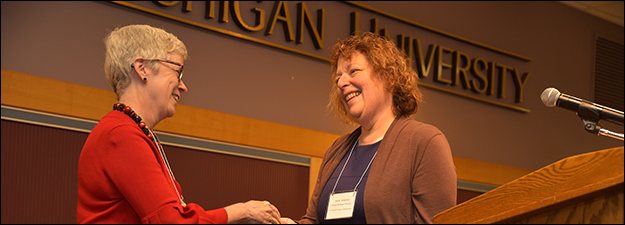The Western Iberian Kingdoms after 1143 I
Sponsoring Organization(s)
Instituto de Estudios Medievales, Univ. de León; Instituto de Estudos Medievais, Univ. Nova de Lisboa
Organizer Name
Alicia Miguélez Cavero, María Dolores Teijeira Pablos
Organizer Affiliation
Instituto de Estudos Medievais, Univ. Nova de Lisboa, Instituto de Estudios Medievales, Univ. de León
Presider Name
Alicia Miguélez Cavero
Paper Title 1
The Circulation of Regular and Secular Canons between the Kingdoms of León and Portugal during the Twelfth Century: The Cases of Braga, Coimbra, León, and Zamora
Presenter 1 Name
Maria João Branco
Presenter 1 Affiliation
Instituto de Estudos Medievais, Univ. Nova de Lisboa
Paper Title 2
In the Middle of Two Kingdoms: Romanesque Workshops, Patterns, and Artistic Patronage in the Borders between Galicia and Portugal
Presenter 2 Name
Margarita Vázquez Corbal
Presenter 2 Affiliation
Univ. de Santiago de Compostela
Paper Title 3
Portugal in the Chronicles of Twelfth-Century Castile and Leon
Presenter 3 Name
Israel San Martín
Presenter 3 Affiliation
Univ. de Santiago de Compostela
Start Date
12-5-2017 1:30 PM
Session Location
Schneider 1245
Description
The Western Iberian Kingdoms after 1143
Kalamazoo Congress 2017
The year 1143 was decisive for the birth of what is today considered the oldest nation-state of the Western world: Portugal. On October 5, 1143 King Alfonso VII of León and Castile and his cousin Afonso Henriques signed the so-called Treaty of Zamora under the auspices of the papal envoy Cardinal Guido de Vico. This agreement meant the recognition of the title of King for Alfonso Henriques by Alfonso VII of León. Three months later, on December 13, the Portuguese King addressed the letter Clavis Regni to Rome asking to become vassal of the pope, a process that would only finish in 1179, when Pope Alexander III officially recognised Afonso Henriques as the first King of Portugal through the bull Manifestis Probatum.
The new-born kingdom would keep its independence during the entire medieval period, despite the several attempts of its neighbouring territories to reincorporate it. The establishment of territorial borders and political frontiers between Portugal and the surrounding Western Iberian territories –which politically evolved until becoming the united kingdom of León and Castile in 1230- did obviously not imply the isolation of these territories, which shared similar needs and aims, a common enemy in the south and the same religious and cultural background. Rather, Portugal, Galicia, León and Castile show an intense cluster of political, economical, social and cultural exchanges and relationships which have not been explored in-depth so far but could actually led to reconsider the concepts of frontiers and borders in medieval times, as well as to advance knowledge in the role played by these territories in both the Iberian and European contexts during the Middle Ages.
The Instituto de Estudios Medievales of the University of León and the Instituto de Estudos Medievais of the Nova University in Lisbon have previous experience on collaborative work together, specially in the co-organization of scientific meetings. As a further step, and for the first time for the Kalamazoo Congress on Medieval Studies, they sponsor two interdisciplinary sessions on the topic “The Western Iberian Kingdoms after 1143”, addressed by scholars from several disciplines, those including History, Art History, Literature and Musicology. These results are intended to become the basis to further discuss the concept of border in Medieval Iberia.
ALICIA MIGUÉLEZ CAVERO
The Western Iberian Kingdoms after 1143 I
Schneider 1245
The Western Iberian Kingdoms after 1143
Kalamazoo Congress 2017
The year 1143 was decisive for the birth of what is today considered the oldest nation-state of the Western world: Portugal. On October 5, 1143 King Alfonso VII of León and Castile and his cousin Afonso Henriques signed the so-called Treaty of Zamora under the auspices of the papal envoy Cardinal Guido de Vico. This agreement meant the recognition of the title of King for Alfonso Henriques by Alfonso VII of León. Three months later, on December 13, the Portuguese King addressed the letter Clavis Regni to Rome asking to become vassal of the pope, a process that would only finish in 1179, when Pope Alexander III officially recognised Afonso Henriques as the first King of Portugal through the bull Manifestis Probatum.
The new-born kingdom would keep its independence during the entire medieval period, despite the several attempts of its neighbouring territories to reincorporate it. The establishment of territorial borders and political frontiers between Portugal and the surrounding Western Iberian territories –which politically evolved until becoming the united kingdom of León and Castile in 1230- did obviously not imply the isolation of these territories, which shared similar needs and aims, a common enemy in the south and the same religious and cultural background. Rather, Portugal, Galicia, León and Castile show an intense cluster of political, economical, social and cultural exchanges and relationships which have not been explored in-depth so far but could actually led to reconsider the concepts of frontiers and borders in medieval times, as well as to advance knowledge in the role played by these territories in both the Iberian and European contexts during the Middle Ages.
The Instituto de Estudios Medievales of the University of León and the Instituto de Estudos Medievais of the Nova University in Lisbon have previous experience on collaborative work together, specially in the co-organization of scientific meetings. As a further step, and for the first time for the Kalamazoo Congress on Medieval Studies, they sponsor two interdisciplinary sessions on the topic “The Western Iberian Kingdoms after 1143”, addressed by scholars from several disciplines, those including History, Art History, Literature and Musicology. These results are intended to become the basis to further discuss the concept of border in Medieval Iberia.
ALICIA MIGUÉLEZ CAVERO


